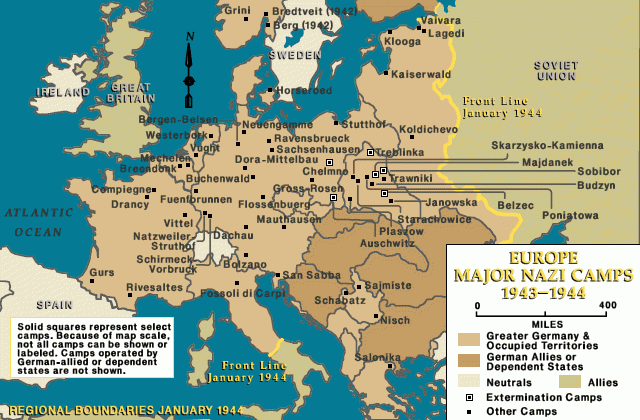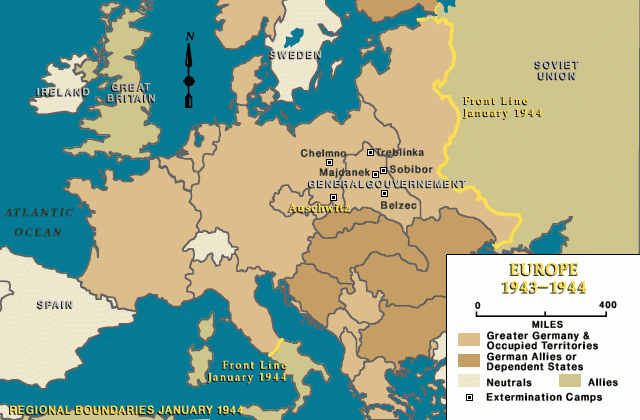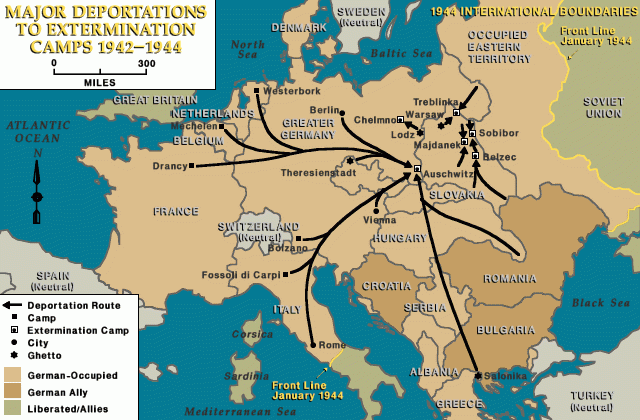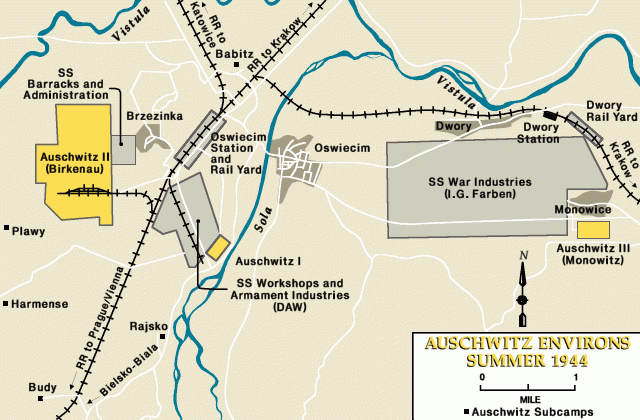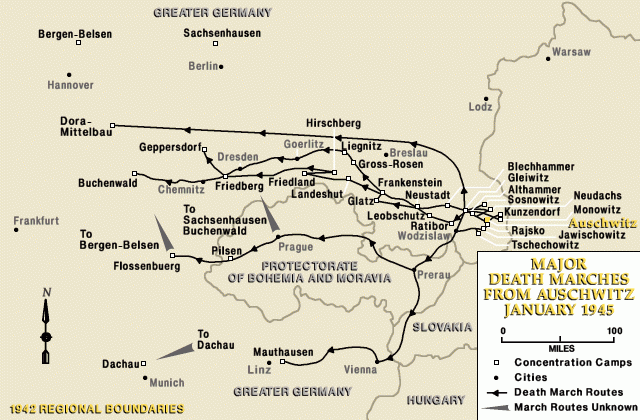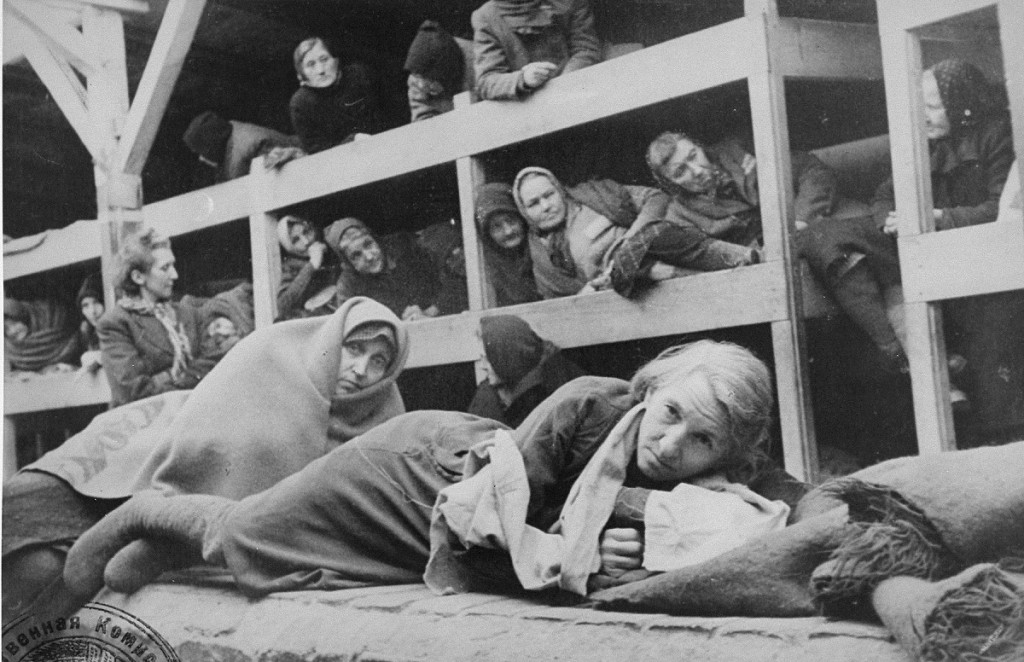
Auschwitz
The largest of its kind, the Auschwitz camp complex was essential to carrying out the Nazi plan for the "Final Solution." Auschwitz left its mark as one of the most infamous camps of the Holocaust.
Key Facts
-
1
Located in German-occupied Poland, Auschwitz consisted of three camps including a killing center. The camps were opened over the course of nearly two years, 1940-1942. Auschwitz closed in January 1945 with its liberation by the Soviet army.
-
2
More than 1.1 million people died at Auschwitz, including nearly one million Jews. Those Jews who were not sent directly to gas chambers were selected for forced labor.
-
3
The Auschwitz complex differed from the other Nazi killing centers because it included a concentration camp and a labor camp as well as large gas chambers and crematoria at Birkenau constructed for the mass murder of European Jews.
Where was Auschwitz Located?
Auschwitz is the German name for the Polish city Oświęcim. Oświęcim is located in Poland, approximately 40 miles (about 64 km) west of Kraków. Germany annexed this area of Poland in 1939.
The Auschwitz concentration camp was located on the outskirts of Oświęcim in German-occupied Poland. It was originally established in 1940 and later referred to as "Auschwitz I" or "Main Camp."
The Auschwitz-Birkenau killing center, also referred to as "Auschwitz II," was located near the Polish village Brzezinka (German: Birkenau). This is about 2 miles (just over 3 km) from the Main Camp. The Germans started construction on Auschwitz-Birkenau in 1941.
Auschwitz III or Monowitz was located near the Polish village of Monowice (German: Monowitz). This is about 4 miles (approximately 6.5 kilometers) from the Main Camp. The Germans initially established the Buna subcamp there in 1942. In 1943, it became a concentration camp.
The Auschwitz camp complex also included numerous subcamps. The majority of these subcamps were located in the region around Auschwitz.
Number of Victims
It is estimated that the SS and police deported at least 1.3 million people to the Auschwitz camp complex between 1940 and 1945. Of these deportees, approximately 1.1 million people were murdered.
The best estimates of the number of victims at the Auschwitz camp complex, including the killing center at Auschwitz-Birkenau, between 1940 and 1945 are:
- Jews (1,095,000 deported to Auschwitz, 960,000 died)
- Non-Jewish Poles (140,000-150,000 deported, 74,000 died)
- Roma (Gypsies) (23,000 deported, 21,000 died)
- Soviet prisoners of war (15,000 deported and died)
- Other nationalities (25,000 deported, 10,000-15,000 died)
During the Holocaust, concentration camp prisoners received tattoos only at one location, Auschwitz. Incoming prisoners were assigned a camp serial number which was sewn to their prison uniforms. Only those prisoners selected for work were issued serial numbers; those prisoners sent directly to the gas chambers were not registered and received no tattoos.
Auschwitz I
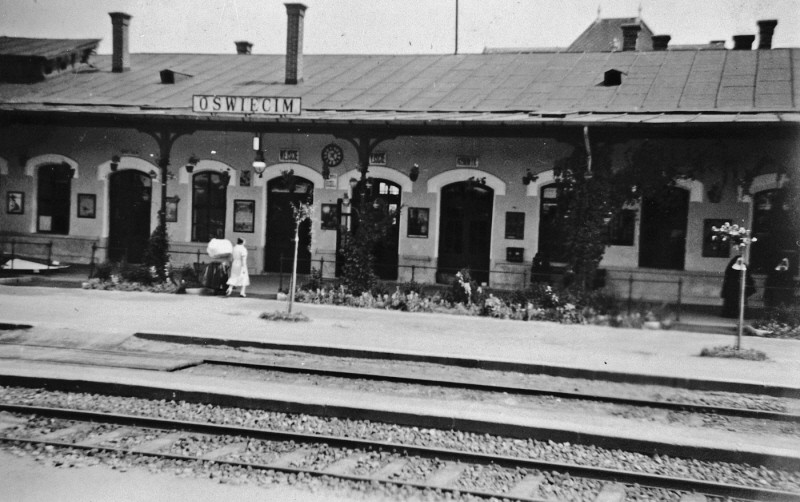
Auschwitz I, the main camp, was the first camp established near Oświęcim. Construction began in April 1940 in an abandoned Polish army barracks in a suburb of the city.
SS authorities continuously used prisoners for forced labor to expand the camp. During the first year of the camp’s existence, the SS and police cleared a zone of approximately 40 square kilometers (15.44 square miles) as a “development zone” reserved for the exclusive use of the camp.
On May 20, 1940, the first prisoners arrived at Auschwitz. The transport consisted of some 30 German inmates, categorized as "professional criminals." The SS had selected them from the Sachsenhausen concentration camp outside of Berlin. Less than a month later, on June 14, German authorities in occupied Poland deported 728 Polish prisoners from a prison in Tarnów to Auschwitz. This was the first of many transports of Poles to the Auschwitz camp.
Like most German concentration camps, Auschwitz I was constructed for three purposes:
- To incarcerate real and perceived enemies of the Nazi regime and the German occupation authorities in Poland for an indefinite period of time
- To provide a supply of forced laborers for deployment in SS-owned construction-related enterprises (and, later, armaments and other war-related production)
- To serve as a site to kill small, targeted groups of the population whose death was determined by the SS and police authorities to be essential to the security of Nazi Germany.
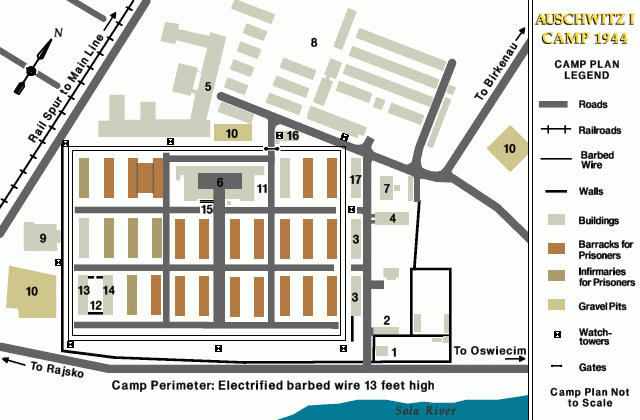
Like some concentration camps, Auschwitz I had a gas chamber and crematorium. Initially, SS engineers constructed an improvised gas chamber in the basement of the prison block, Block 11. Later a larger, permanent gas chamber was constructed as part of the original crematorium in a separate building outside the prisoner compound.
At Auschwitz I, SS physicians carried out medical experiments in the hospital, Barrack (Block) 10. They conducted pseudoscientific research on infants, twins, and dwarfs, and performed forced sterilizations and castrations of adults. The best-known of these physicians was SS Captain Dr. Josef Mengele.
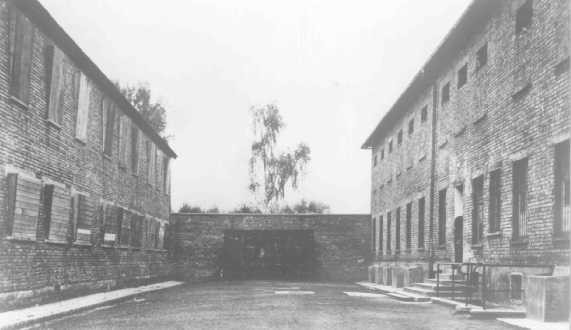
Between the medical-experiments barrack and the prison block (Block 11) stood the "Black Wall," where SS guards executed thousands of prisoners.
Auschwitz II (Auschwitz-Birkenau)

Construction of Auschwitz II, or Auschwitz-Birkenau, began at Brzezinka in October 1941.
Of the three camps established near Oswiecim, the Auschwitz-Birkenau camp had the largest total prisoner population. It was divided into ten sections separated by electrified barbed-wire fences. Like Auschwitz I, it was patrolled by SS guards, including—after 1942—SS dog handlers.
The camp included sections for women; men; a family camp for Roma (Gypsies) deported from Germany, Austria, and the Protectorate of Bohemia and Moravia; and a family camp for Jewish families deported from the Theresienstadt ghetto.
Auschwitz-Birkenau was also a killing center and played a central role in the German effort to kill the Jews of Europe. Around the beginning of September, 1941, the SS at Auschwitz I conducted the first tests of Zyklon B as a mass murder agent, using Soviet POWs and debilitated Polish prisoners as victims. The “success” of these experiments led to the construction of a chamber in the crematorium of Auschwitz I that, like the subsequent gas chambers at Auschwitz, used Zyklon B to murder victims. The first transports of Jewish men, women, and children sent to Auschwitz as part of the “final solution” were murdered in this gas chamber (Crematorium I) in February and March 1942.
During the first half of 1942, the Auschwitz SS moved the gassing operations to Auschwitz-Birkenau by converting two farmhouses just outside the camp’s fence into gas chambers. Bunker I began operating in spring 1942, the larger Bunker II in mid-summer 1942.
These gassing facilities soon proved inadequate for the task of murdering the large numbers of Jewish deportees being sent to Auschwitz. Between March and June 1943, four large crematoria were built within Auschwitz-Birkenau, each with a gas chamber, a disrobing area, and crematory ovens. Gassings ceased at Bunkers I and II when Crematoria II through V began operating, although Bunker II was put back into operation during the deportation of Hungary’s Jews in 1944. Gassing of newly arrived transports ceased at Auschwitz by early November 1944.
Jewish deportees arriving at Auschwitz-Birkenau immediately underwent selection. The SS staff chose some of the able-bodied for forced labor and sent the rest directly to the gas chambers, which were disguised as shower installations to mislead the victims. The belongings of all deportees were confiscated and sorted in the "Kanada" (Canada) warehouse for shipment back to Germany. Canada symbolized wealth to the prisoners.
Deportations to Auschwitz
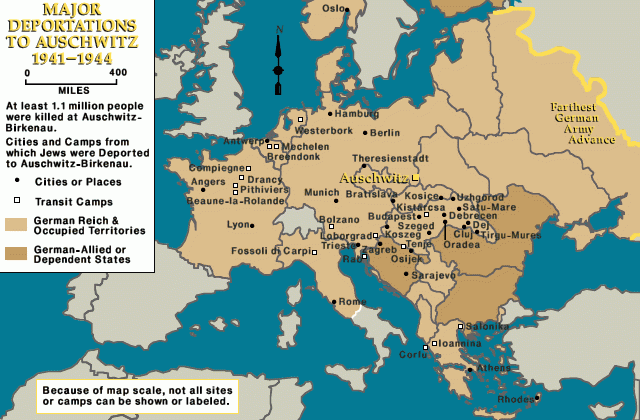
Trains arrived at Auschwitz frequently with transports of Jews from virtually every country in Europe occupied by or allied to Germany. These transports arrived from early 1942 to early November 1944. The approximate breakdown of deportations from individual countries is:
- Hungary: 426,000
- Poland: 300,000
- France: 69,000
- Netherlands: 60,000
- Greece: 55,000
- Bohemia and Moravia: 46,000
- Slovakia: 27,000
- Belgium: 25,000
- Yugoslavia: 10,000
- Italy: 7,500
- Norway: 690
- Other (including concentration camps): 34,000
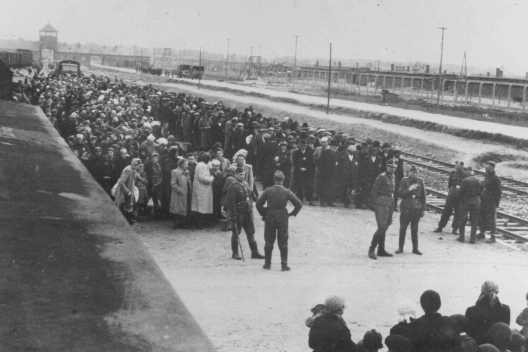
With the deportations from Hungary, the role of Auschwitz-Birkenau in the German plan to murder the Jews of Europe achieved its highest effectiveness. Between late April and early July 1944, approximately 440,000 Jews were deported from Hungary. Of the nearly 426,000 Hungarian Jews deported to Auschwitz, approximately 320,000 of them were sent directly to the gas chambers in Auschwitz-Birkenau. They deployed approximately 110,000 at forced labor in the Auschwitz camp complex. The SS authorities transferred many of these Hungarian Jewish forced laborers within weeks of their arrival in Auschwitz to other concentration camps in Germany and Austria.
The Prisoner Revolt at Auschwitz
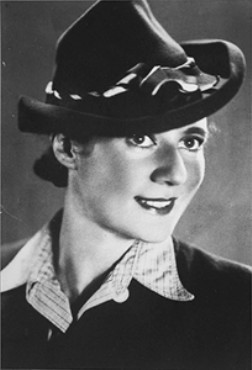
On October 7, 1944, several hundred prisoners assigned to Crematorium IV at Auschwitz-Birkenau rebelled after learning that they were going to be killed. During the uprising, the prisoners killed three guards and blew up the crematorium and adjacent gas chamber. The prisoners used explosives smuggled into the camp by Jewish women who had been assigned to forced labor in a nearby armaments factory.
The Germans crushed the revolt and killed almost all of the prisoners involved in the rebellion. The Jewish women who had smuggled the explosives into the camp were publicly hanged in early January 1945.
The Auschwitz SS stopped gassing newly arrived prisoners by early November 1944. On orders from Himmler, camp officials began dismantling the crematoria. The SS destroyed the remaining gassing installations as Soviet forces approached in January 1945.
Auschwitz III
Auschwitz III, also called Buna or Monowitz, was established in October 1942. It housed prisoners assigned to work at the Buna synthetic rubber works, located on the outskirts of the small village of Monowice.
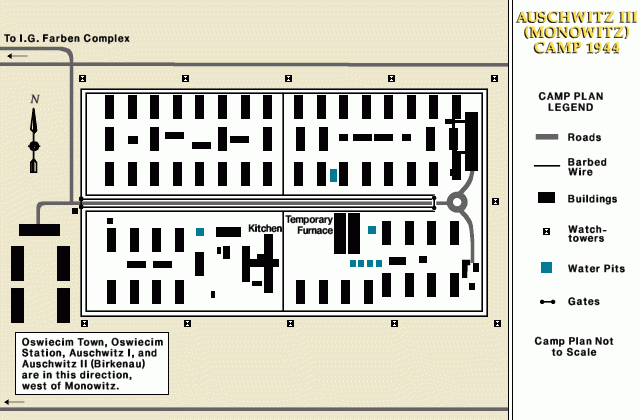
In the spring of 1941, German conglomerate I.G. Farben established a factory in which its executives intended to exploit concentration camp labor to manufacture synthetic rubber and fuels. I.G. Farben invested more than 700 million Reichsmarks (about 2.8 million US dollars in 1941 terms) in Auschwitz III. From May 1941 until July 1942, the SS had transported prisoners from Auschwitz I to the “Buna Detachment,” at first on foot and later by rail. (Between July and October 1942 there was a pause in transports, due to a typhus epidemic and quarantine.) With the construction of Auschwitz III in the autumn of 1942, prisoners deployed at Buna lived in Auschwitz III.
Auschwitz III also had a so-called Labor Education Camp for non-Jewish prisoners who were perceived to have violated German-imposed labor discipline.
Auschwitz Subcamps
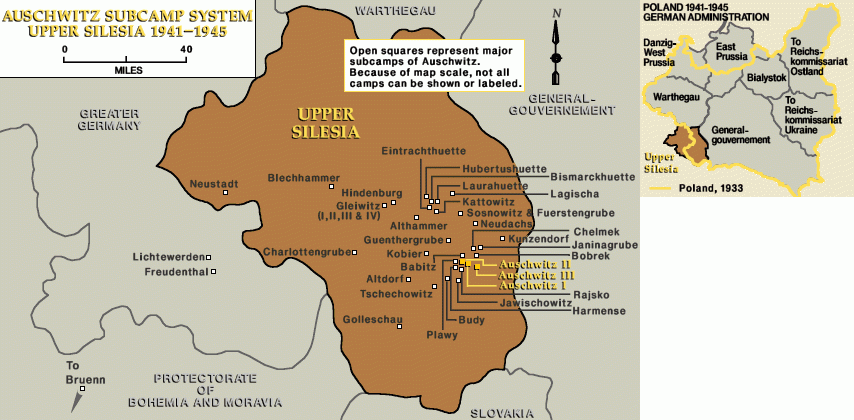
Between 1942 and 1944, the SS authorities at Auschwitz established 44 subcamps. Some of them were established within the officially designated “development” zone, including Budy, Rajsko, Tschechowitz, Harmense, and Babitz. Others, such as Blechhammer, Gleiwitz, Althammer, Fürstengrube, Laurahuette, and Eintrachthuette were located in Upper Silesia north and west of the Vistula River. Some subcamps, such as Freudenthal and Bruenn (Brno), were located in Moravia.
In general, subcamps that produced or processed agricultural goods were administratively subordinate to Auschwitz-Birkenau. Subcamps whose prisoners were deployed at industrial and armaments production or in extractive industries (e.g., coal mining, quarry work) were administratively subordinate to Auschwitz-Monowitz. This division of administrative responsibility was formalized after November 1943.
Auschwitz inmates were employed on huge farms, including the experimental agricultural station at Rajsko. They were also forced to work in coal mines, in stone quarries, in fisheries, and especially in armaments industries such as the SS-owned German Equipment Works (established in 1941). Periodically, prisoners underwent selection. If the SS judged them too weak or sick to continue working, they were transported to Auschwitz-Birkenau and killed.
Prisoners selected for forced labor were registered and tattooed with identification numbers on their left arms in Auschwitz I. They were then assigned to forced labor at the main camp or elsewhere in the complex, including the subcamps.
Evacuation of Auschwitz and its Subcamps
In mid-January 1945, as Soviet forces approached the Auschwitz concentration camp complex, the SS began evacuating Auschwitz and its subcamps.
SS units forced nearly 60,000 prisoners to march west from the Auschwitz camp system. Thousands had been killed in the camps in the days before these death marches began.
Tens of thousands of prisoners, mostly Jews, were forced to march either northwest for 55 kilometers (approximately 30 miles) to Gliwice (Gleiwitz) or due west for 63 kilometers (approximately 35 miles) to Wodzislaw (Loslau) in the western part of Upper Silesia. Those forced to march northwest were joined by prisoners from subcamps in East Upper Silesia, such as Bismarckhuette, Althammer, and Hindenburg. Those forced to march due west were joined by inmates from the subcamps to the south of Auschwitz, such as Jawischowitz, Tschechowitz, and Golleschau.
SS guards shot anyone who fell behind or could not continue. Prisoners also suffered from the cold weather, starvation, and exposure on these marches. At least 3,000 prisoners died on route to Gliwice alone. Possibly as many as 15,000 prisoners died during the evacuation marches from Auschwitz and the subcamps.
Upon arrival in Gliwice and Wodzislaw, the prisoners were put on unheated freight trains and transported to concentration camps in Germany, particularly to Flossenbürg, Sachsenhausen, Gross-Rosen, Buchenwald, Dachau, and also to Mauthausen in Austria. The rail journey lasted for days. Without food, water, shelter, or blankets, many prisoners did not survive the transport.
In late January 1945, SS and police officials forced 4,000 prisoners to evacuate Blechhammer on foot. Blechhammer was a subcamp of Auschwitz-Monowitz. The SS murdered about 800 prisoners during the march to the Gross-Rosen concentration camp. SS officials also killed as many as 200 prisoners left behind in Blechhammer as a result of illness or unsuccessful attempts to hide. After a brief delay, the SS transported around 3,000 Blechhammer prisoners from Gross-Rosen to the Buchenwald concentration camp in Germany.
The Liberation of Auschwitz
On January 27, 1945, the Soviet army entered Auschwitz, Birkenau, and Monowitz and liberated about seven thousand prisoners, most of whom were ill and dying.
Critical Thinking Questions
Why has the Auschwitz complex become a symbol of the Holocaust?
Besides the SS, what organizations or professions were involved in the design, construction, and operation of the camp?
Were the German and Polish populations aware of Auschwitz, its purposes, and the conditions within? How would you begin to research this question?


